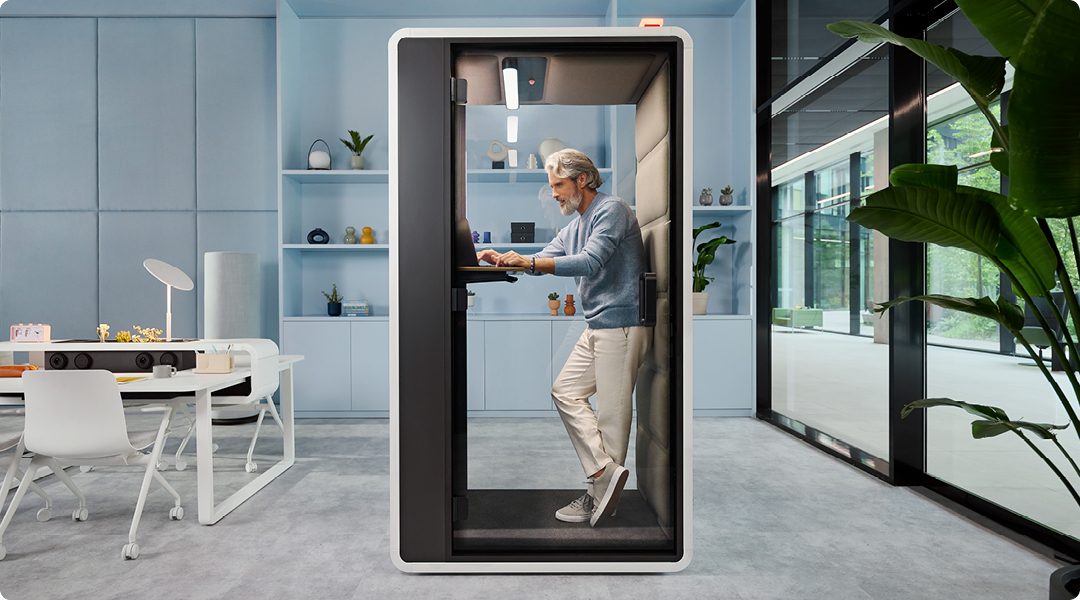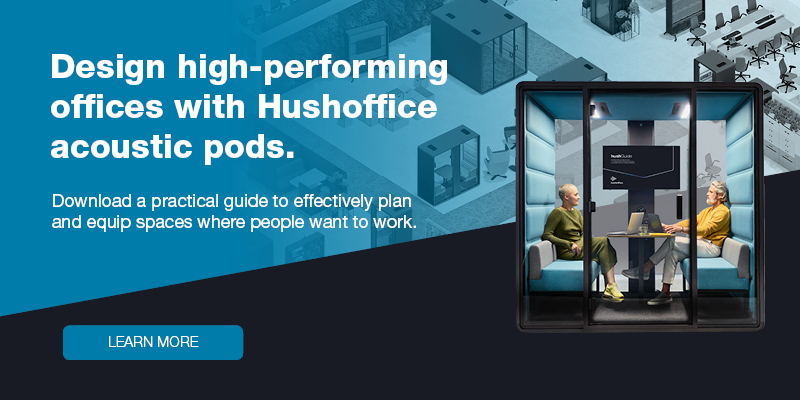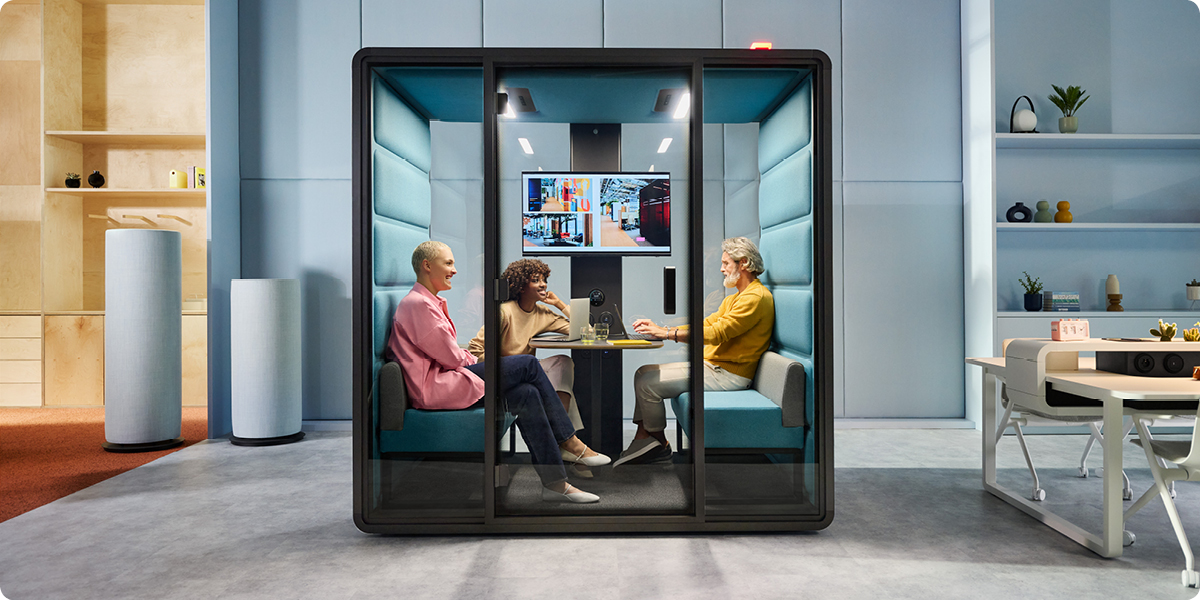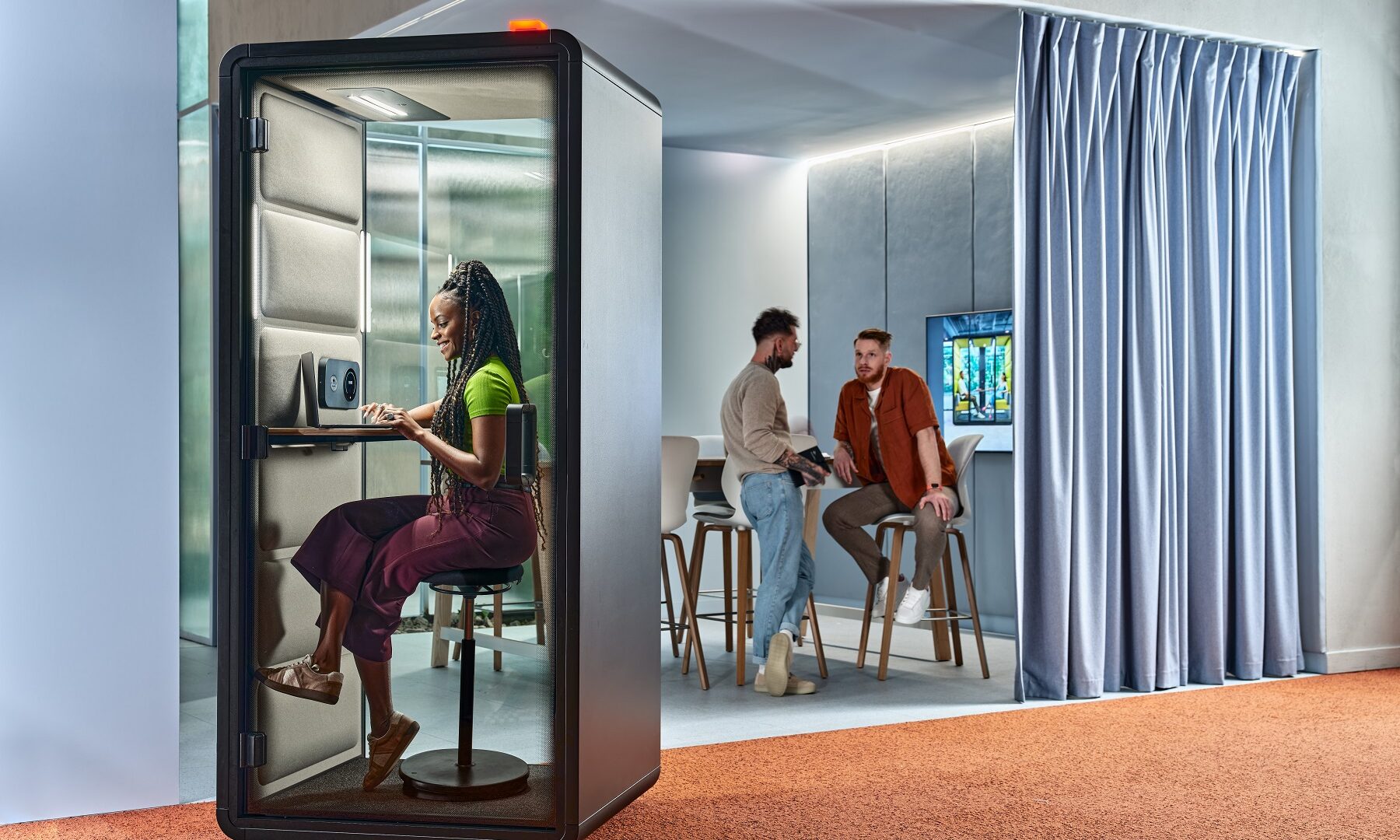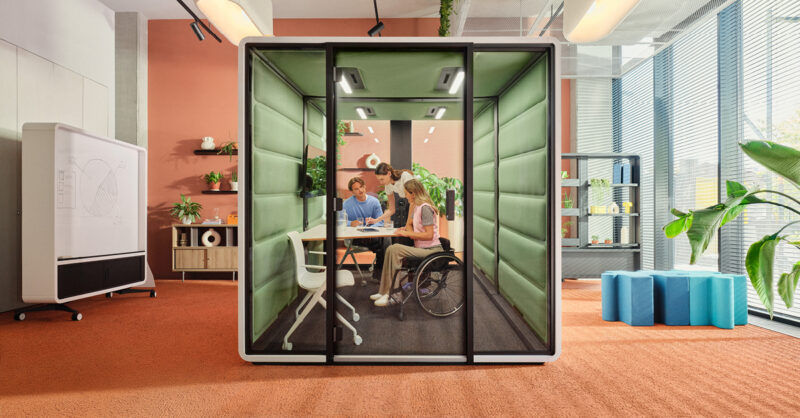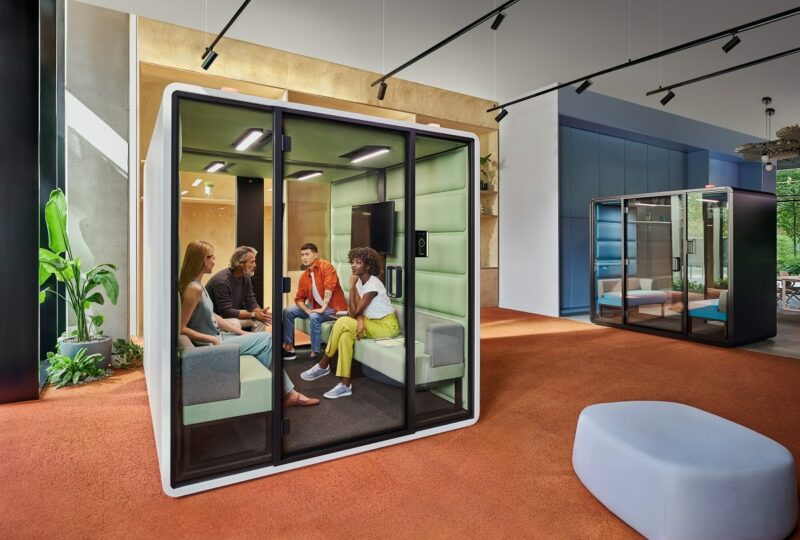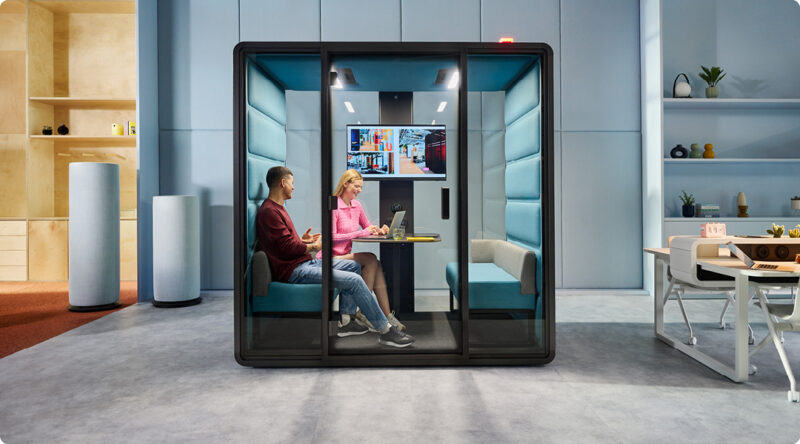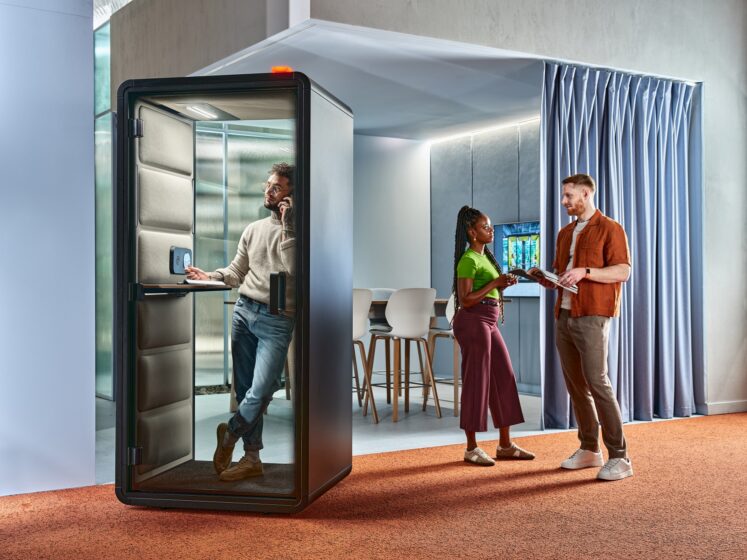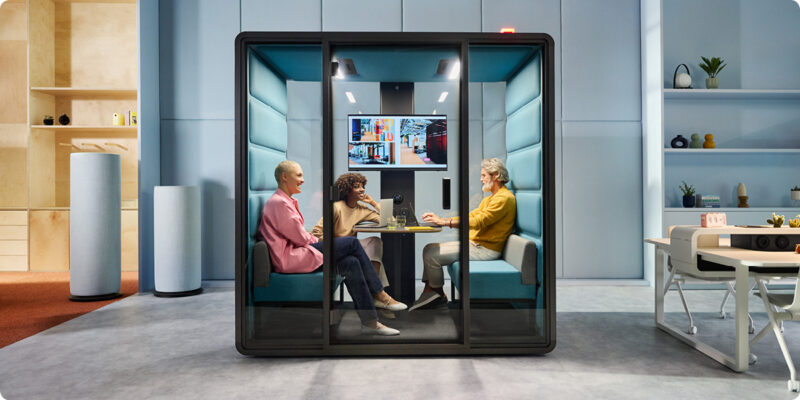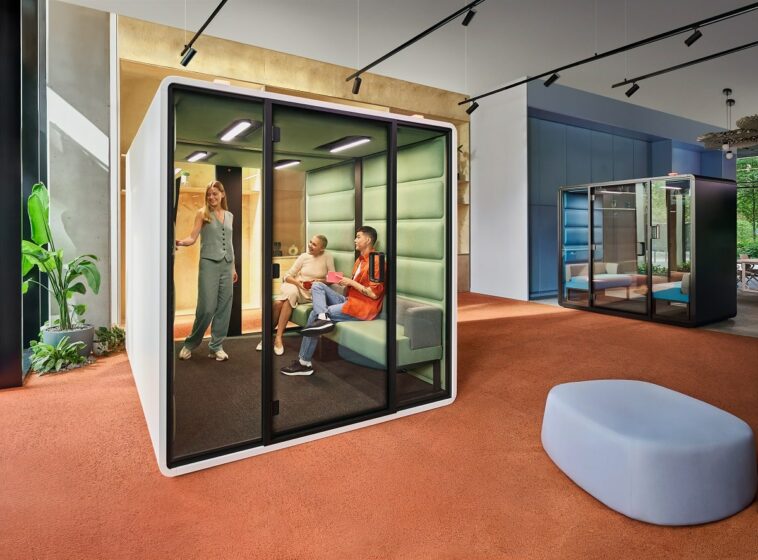Designing an office that supports job satisfaction
- Posted on: 13 June 2025
- By: Hushoffice Team
True satisfaction at work reflects how an organisation supports us — not only in a practical sense but culturally and emotionally. In this post, we examine the many elements that influence satisfaction and show how acoustic pods like hushFree translate good intentions into everyday experiences.
Office design for job satisfaction – tl;dr
- Job satisfaction keeps us connected to our roles — it’s the unspoken agreement between effort and reward. More than just an exchange, it mirrors the workplace, revealing company culture and operational values. That’s why offers a unique lens into the health of any organisation.
- The setup of a workspace — including its noise control, comfort, adaptability, and vibe — plays a decisive role in how employees feel about their jobs. Respect for different styles of working and for neurodiverse needs means providing the basics: comfort, choice, and a sense of inclusion. Acoustic pods like hushFree offer relief from distractions, encourage focus, and give people the freedom to work the way that suits them best.
- Satisfaction is measurable, but more importantly, it’s felt. Whether it’s the gentle support of a well-designed chair or the quiet within an acoustic booth, a considered physical setting reflects deeper values like dignity and care. These are not merely practical features — they’re markers of a workplace designed with human beings in mind.
What shapes job satisfaction most?
Scholars have long sought to define the building blocks of job contentment. The most consistent factors are autonomy, purpose, and a strong organisational culture. Meaningful tasks and an environment that is supportive tend to outweigh even generous perks.
Is satisfaction only about a good paycheque?
Salary matters, but it’s not the whole story. Many workers place more value on being treated fairly, having space to grow, and receiving emotional support than they do on pay alone.
Does the physical environment make a difference?
Absolutely. Everything from lighting to layout affects not just how we work, but how we feel. And when it comes to comfort, sound is often the most overlooked culprit. Research shows that the negative effect of noise is more pronounced than that of light or temperature.
How does leadership impact workplace satisfaction?
Supportive leadership — especially styles that include staff in decisions — has a strong positive correlation with satisfaction levels. When managers listen, empower, and remove obstacles, people feel they have real agency over their work.
The quality of workplace relationships matters.
We’re social beings, and the bonds we form at work directly impact how satisfied we feel. For example, employees with close work friendships are significantly more apt to be highly invested in their work — some estimates say up to seven times more.
How does workplace mood affect well-being?
Tension in the air can become an invisible drain, much like static that clouds your thinking. But a setting that radiates clarity, encouragement, and positivity allows people to thrive.
Striking a balance between teamwork and competition…
Healthy rivalry can encourage fresh ideas, but collaboration builds up those bridges that ideas need. A smart office layout helps maintain the right mix — energising, but not overwhelming.
In today’s hybrid setups, the happiest teams are those working in spaces that naturally support collaboration and knowledge exchange. There’s the felt atmosphere — made of norms and emotions — but underneath, it’s shaped by design. Layouts, zones, and circulation flow determine how work happens. That’s why hushFree booths are essential, whether you’re in a large open-plan setting or a smaller private office. They offer instant access to peace, privacy, or joint focus, depending on what the moment demands. They’re places of dependable concentration
– says Principal Brand Manager, Mateusz Barczyk, Hushoffice.
Shared areas can spark inspiration…
Common spaces, if thoughtfully set up, become the heart of idea exchange. But without clear boundaries, open layouts can tire people out. That’s where solutions such as hushFree booths complete the picture, offering balance between openness and retreat.
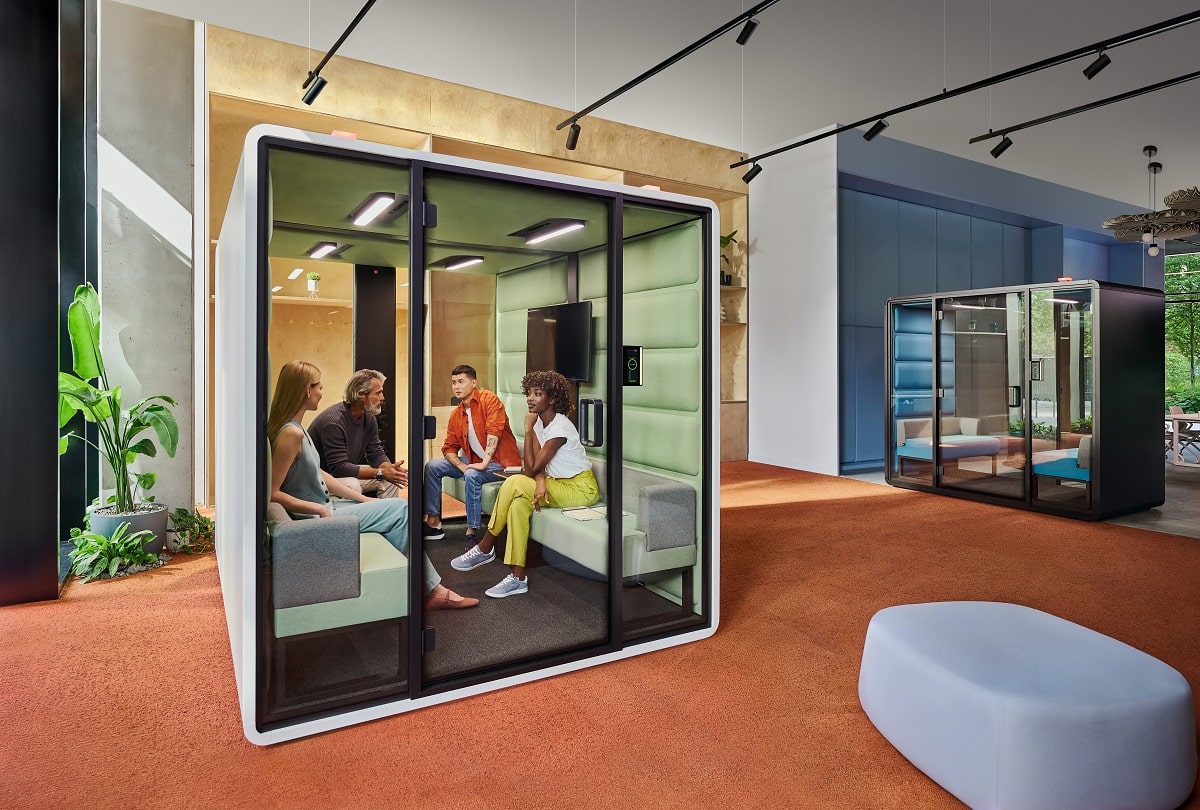
Is your office somewhere people want to be — or merely where they have to be?
This is a central question when it comes to job fulfilment. Workplaces that feel clinical or uninspiring won’t nurture motivation or loyalty. But offices that respond to their people’s rhythms and needs can become environments of shared purpose.
Ergonomics. Why comfort equals care.
Supportive furniture and good lighting make all the difference. Discomfort caused by rigid seating, glare, or awkward setups isn’t just distracting — it signals a lack of consideration. In contrast, environments tailored to physical well-being send a clear message: your presence here matters. Take the hushFree.S pod for one person, for instance — it includes a sit or stand desk to encourage healthy posture changes throughout the day.
Good design uplifts mood and morale.
Beautiful surroundings aren’t just nice to have — they reflect intent. Colour palettes, textures, and how space flows all influence how people feel. Visual harmony can quietly reinforce persistence and pride in one’s work.
Adaptability, content creation ease, and task efficiency.
The employees of today expect flexibility in how and where they work — whether solo or as part of a team. That’s why adaptable systems and spatial designs are central to forward-thinking office plans. When the environment bends to people — and not the other way round — satisfaction follows.
Can you concentrate properly in your workplace? How acoustics influence focus and efficiency
Today’s world is filled with noise, and our ability to focus has become ever more delicate. In fact, cognitive performance may drop by up to 15% in a loud office. Unsurprisingly, excess noise also contributes to greater stress levels and mental exhaustion.
How does background noise undermine well-being when at work?
Research shows that continuous background sound raises cortisol levels and weakens working memory. Over time, it chips away at our mental resilience, much like waves gradually eroding a cliff. It’s a kind of stress that may go unnoticed, yet it’s always present. That’s precisely why quiet spaces such as hushFree pods are such well-judged additions to today’s offices — they provide a deliberate break from the noise, allowing the mind to recharge
– explains Principal Brand Manager, Mateusz Barczyk, Hushoffice.
Team meeting acoustic booths such as hushFree.M redefine what an office can offer.
They’re adaptable, inviting, and their design keeps both acoustic and mental comfort in mind. By shielding employees from the chatter of open-plan layouts, hushFree booths help people collect their thoughts, stay sharp, and return to tasks with clarity. They’re not about disconnection, but about purposeful privacy — a brief mental retreat before diving back in.
Office booths and pods accommodate a range of working styles without drawing attention to differences.
Some people need uninterrupted quiet. Others thrive with some background activity. And many of us switch preferences depending on the task. For neurodivergent colleagues in particular, being able to fine-tune their sensory environment is vital — they’re often more acutely impacted by noise and visual stimuli. HushFree booths respond to this need quietly. They offer seclusion without fuss or spotlight, subtly underscoring that all working styles deserve respect
– says Hushoffice Principal Brand Manager, Mateusz Barczyk.
Sometimes, all you need is for a space to feel like it’s just yours — even for half an hour. HushFree booths provide that exact sanctuary.
Interaction and privacy, in harmony.
The best work often emerges through a back-and-forth between solitary thinking and group interaction. One-person pods like hushFree.XS focus pod for one allow teams to fall into that natural rhythm — pulling away to concentrate, then regrouping to share insights. After all, meaningful collaboration begins with a clear head.
Lower stress, greater concentration.
Pods help limit sensory overload and reduce mental strain. Their calming effect works both psychologically and physically: a relaxed body supports a sharper mind. For teams with a variety of needs, options like hushFree.Access.M and the larger hushFree.Access.L provide inclusive support.
Can we truly measure job satisfaction?
To a degree — yes. Tools such as engagement surveys, wellness metrics and attrition rates give a sense of how things stand. But the real picture goes deeper, needing a careful and nuanced view. Numbers provide a sketch, not the full portrait.
Satisfaction on the job is a lived experience. It plays out in the ease of your posture, the natural rhythm of the day, the relief of a quiet corner where you can gather your thoughts. In well-designed booths, employees find more than just silence — they find reassurance that their process is recognised and supported. These are not ordinary enclosures, but precision-built environments for focus and calm. They offer not only peace but a physical expression of care. They give form to something intangible — proving that satisfaction is not just tracked, but thoughtfully made
– says Hushoffice Principal Brand Manager, Mateusz Barczyk.
Office design for job satisfaction – tl;dr
- Job satisfaction keeps us connected to our roles — it’s the unspoken agreement between effort and reward. More than just an exchange, it mirrors the workplace, revealing company culture and operational values. That’s why offers a unique lens into the health of any organisation.
- The setup of a workspace — including its noise control, comfort, adaptability, and vibe — plays a decisive role in how employees feel about their jobs. Respect for different styles of working and for neurodiverse needs means providing the basics: comfort, choice, and a sense of inclusion. Acoustic pods like hushFree offer relief from distractions, encourage focus, and give people the freedom to work the way that suits them best.
- Satisfaction is measurable, but more importantly, it’s felt. Whether it’s the gentle support of a well-designed chair or the quiet within an acoustic booth, a considered physical setting reflects deeper values like dignity and care. These are not merely practical features — they’re markers of a workplace designed with human beings in mind.
Job satisfaction – FAQ
How can managers spot falling satisfaction before people start leaving?
Often, early signs emerge well before resignations. Less engagement during meetings, fewer new ideas, and more frequent sick days may hint at a decline in morale. Regular check-ins — especially in quiet, non-judgemental settings such as acoustic booths — help catch concerns early. Being present and responsive is essential for protecting job satisfaction before it dips too far.
Why is a physical space more effective than digital wellness tools?
While apps and platforms play a role, physical environments affect us in real time and at a sensory level. Thoughtfully designed pods create a tangible feeling of calm that no screen can do. These booths don’t just solve logistical challenges — they transform the mood of the workplace and give employees real permission to pause, reflect, and focus.
How do hushFree pods foster inclusivity and emotional safety?
They give every team member, no matter their personality or neurotype, equal access to spaces where they can control their environment and find focus. There’s no sense of being singled out. These booths promote psychological safety by meeting diverse needs quietly and respectfully — it’s inclusive design brought to life, giving all employees the tools they need to thrive.
